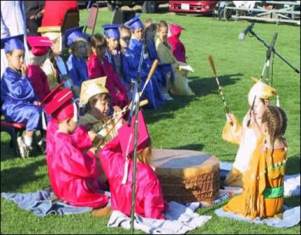
Introduction
That state we now call Oregon has been the homeland of diverse Native peoples since time immemorial. Their descendants, and Native people from throughout the United States, continue to live and thrive here.Developing an understanding of the diverse lifeways of today’s Native people and the legacy of our nation’s growth offers all people the opportunity to develop a shared future.
Historically, American Indian/Alaska Native Education is a rocky path. Many factors contribute to the Academic Achievement Gap that exists between American Indian/Alaska Native learners and their peers. Whether Native students are dropping out or stepping out, the result is the same, low employment rates, depressed economic development in Indian Country, separatism, and poverty.
In May 2025, The Office of Indian Education, in partnership with the Office of Research, Assessment, Data, Accountability, has released the 2023-24 American Indian/Alaska Native Students in Oregon: A Review of Key Indicators report. This report provides a comprehensive and inclusive overview of Native student educational experiences and outcomes statewide, while honoring the full diversity of American Indian/Alaska Native student identities, including AI/AN multiracial and AI/AN Hispanic/Latino identifying students (also collectively referred to as AI/AN Plus).
We invite you to read and share the report widely with the public, tribal communities, families, students, educators, researchers and interested parties to support the continued conversation and progress towards Native student success across the state.
Some ways the report may be used to support Native students include:
- Aligning for Student Success: Integrated Guidance application
- Strategic planning
- Student support initiatives
- Grant applications, including information for Title VI Indian Education formula grants
- Tribal Consultation
- Research initiatives and proposals
- Programming for community-based organizations
- Examination of AI/AN student data at local district level for deeper understanding
As part of the Oregon 150 celebration, this video tracing the history of Oregon Tribes residing in the western part of the state was produced by the Western Oregon Tribal OR150 Committee. The video provides both an historical perspective and current information on five of the nine federally recognized Tribes in Oregon. The western Tribes in Oregon are: the Cow Creek Band of Umpqua Tribe of Indians, the Coquille Indian Tribe, the Confederated Tribes of Siletz Indians, the Confederated Tribes of the Grand Ronde, and the Confederated Tribes of the Coos, Lower Umpqua and Siuslaw Indians. Students studying Oregon history or teachers preparing classes on Oregon history will find this video very informative.
Today
The Native population is about 1.4% of the total population in Oregon. American Indian/Alaska Native (AI/AN) and Hawaiian Native students are potentially in every classroom and every district. Oregon is a national leader in adopting a comprehensive plan developed by Native education leaders. The
2020-2025 AI/AN Student Success Plan aligns to the strategic goals and key efforts of the Oregon Department of Education. The 2020-2025 plan focuses on eleven (11) educational objectives with accompanying strategies and measureable outcomes.
The Oregon Department of Education promotes active Tribal communication through the Indian Education Advisor to the Deputy Superintendent.
Executive Order 96-30 was issued by the Governor of the State of Oregon in 1996, it established State Government-to-Government Relations with the nine (9) federally recognized Tribes in Oregon. The purpose of the formal relationship was to improve services and develop avenues for consultation. Under EO 96-30 the
Government to Government Education Cluster was established.
Part C Title VI of the “Every Student Succeeds Act” (ESSA) of 2015 details the national expectations to provide a quality education for American Indian, Alaska and Hawaiian Native students. There are federal grant programs to 1) support the efforts of local educational agencies to meet the culturally related educational needs of Native students so such students can meet academic standards; 2) ensure that students gain knowledge and understanding of Native communities, languages, Tribal histories, traditions and cultures, and 3) to ensure that school staff who serve Native students have the ability to provide culturally appropriate and effective instruction
Office of Indian Education Updates
As we enter this holiday season of giving and receiving, the Office of Indian Education has a gift for you. We are honored to share the “Heart & Spirit of Tribal Consultation" video set. This set of 10 videos includes an opening video and nine individualized videos by which each Tribe shares, in their own words, what tribal consultation and sovereignty means to them. In my role with ODE, I often am asked “What is effective Tribal Consultation when working with Tribes?". Although I can provide some guidance, having a Tribe share their perspectives and expectations on this complex, yet vital topic, is such a wonderful gift.
In Oregon, Tribal Consultation is a legal requirement, and it is a process to engage each Tribe in meaningful conversations and dialogues. I encourage us all to embrace consultation, not only as a requirement, but as an opportunity to improve the lives and communities for all whom call Oregon their home. We want to express our gratitude to the Tribes for their valuable guidance and insight to what Tribal Consultation looks like, feels like, and sounds like. A special thank you to Region 16 Comprehensive Center for funding this project!
As you enjoy viewing this gift, we encourage you to put into practice ideas and strategies shared in these videos to either begin building or strengthen Tribal Consultation efforts.
- April Campbell, Assistant Superintendent
Heart and Spirit of Tribal Consultation Video Series:
To watch the entire series please visit: Heart & Spirit of Tribal Consultation
- American Indian/Alaska Native Success Grants
- The Office of Indian Education Monthly Newsletter: Subscribe
- The White House Initiative on American Indian and Alaska Native Education supports activities that strengthen the nation by expanding education opportunities and improving outcomes for all AI/AN students.
- HB 2052 - Graduation 2025 Letter to Districts
- American Indian/Alaska Native Students in Oregon: A Review of Key Indicators